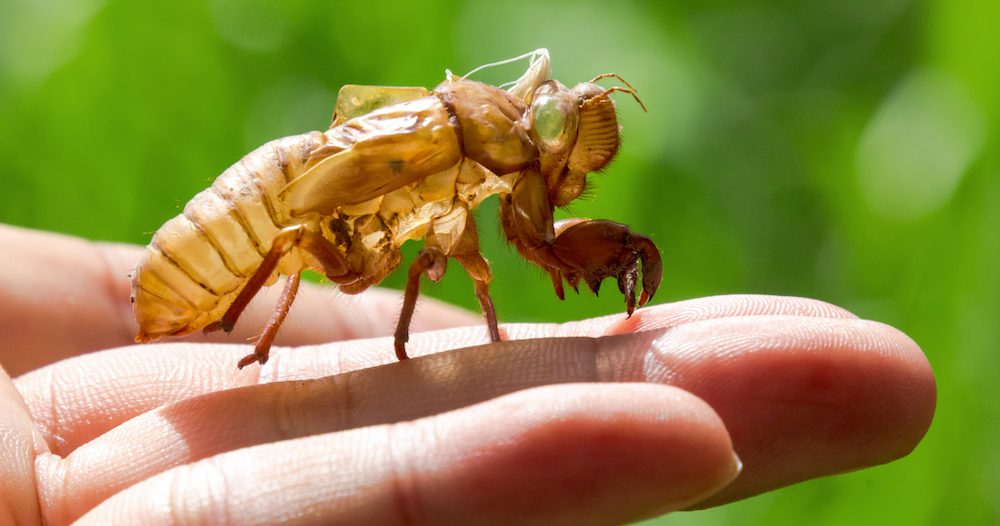
Krit of Studio OMG / Getty Images
They’re here: After remaining buried underground for 17 years, cicadas are out in full force this spring—crawling out from the earth by the thousands, buzzing at volumes that would rival an aircraft carrier, leaving behind a shell of their former self on your trees as a haunting reminder of their presence.
But what are cicadas, and what should homeowners know about this particularly creepy species of bugs? We decided to investigate and pull back the curtain on these mysterious pests once and for all.
Types of cicadas
Before you lump all cicadas into one group, you should know that there are different types. There are two basic groups: annual and periodical.
The cicadas that are appearing now in the South and along the East Coast are the periodical type—meaning that young nymphs burrow underground and stay there, feeding off tree roots until they’ve matured. Then, once every 13 to 17 years, they emerge, mate, shed their skins, and start the process all over again.
Annual cicadas appear every year and are more widespread across the United States.
“Annual cicadas will emerge every late spring or early summer as temperatures rise,” says Glen Ramsey, technical services senior manager for Orkin.
Scientists aren’t totally sure why some cicadas appear exactly every 13 or 17 years. One evolutionary theory: By emerging all at once, the cicadas can better stave off predators and keep their populations large. Another guess is that the cicadas have somehow tuned in to historical cycles and appear when predatory bird populations are lower.
Though cicadas spend the majority of their lives underground, you’ll know that they’ve been in your yard thanks to the distinctive calling cards they leave behind: Tan-colored skins stuck to your trees—lots and lots of ’em.
Why are cicadas so loud?
Some people say it’s just not summer until they hear cicada calls. This loud buzzing sound is made by adults looking for mates. Males make their noise using a drumlike part of their abdomen called the tymbal, while females respond by flicking their wings together. Together, these sounds can top 100 decibels, which leads people to wear earplugs during cicada season in some parts of the country.
This noise is so loud it can be heard up to a half-mile away, which makes cicadas one of the loudest insects in the United States.
Can cicadas damage plants and trees?
Adult cicadas like to feast on the young twigs of trees and shrubs. Their favorite foods? Oak, maple, willow, and ash trees—but really, they will eat just about anything. The underground nymphs, meanwhile, feed on the juices from plant roots.
All this munching on trees—from above and below—can harm the plants in your yard. But it’s important to note that the extent of damage depends on the type of cicada you’re dealing with.
As it turns out, the periodical cicadas are the ones homeowners really need to watch out for.
“Periodical cicadas can cause more damage to plants in a short time because of their mass emergence and feeding. Annual cicadas do not usually cause permanent damage to their host plants,” says Ramsey.
Cicadas can also harm twigs while laying their eggs. The cicada makes a little incision on the twig for her eggs, which may kill off the end of the twig. This damage is usually harmless to established trees—it’s sort of like pruning, Ramsey says—but small trees can become severely damaged or even dead if cicadas are out in full force.
How to protect plants and trees from cicadas
It’s simple for you to protect the trees in your yard from cicadas. You’ll want to wait to plant new trees and shrubs until the fall, when the adult cicadas have died and their nymphs are tucked away safely underground. Annual adult cicadas are active for only four to six weeks, though periodical cicada activity can last for up to two months.
If you’ve already planted new trees, don’t worry—you haven’t given them a death sentence; just read our next point.
How to get rid of cicadas
“People can spray cicadas off of their trees with a garden hose or put something like mesh or cheesecloth around the trunk to prevent cicadas from crawling up,” says Nancy Troyano, a board-certified entomologist and the director of operations, education, and training for Ehrlich Pest Control.
If you have a severe cicada infestation that’s really harming your trees, you may need to call in a professional exterminator. But as a homeowner, you should really just leave the cicadas alone if you can help it. After all, they won’t invade your home, they aren’t venomous, and they do not transmit diseases.
“Treating yards to kill cicadas will result in an unnecessary application of pesticides to the environment, and treating these insects directly may also sicken animals who then try to eat them,” says Troyano.
Furthermore, she says, “the mass emergence of periodical cicadas is a phenomenon that is incredible to witness. If you attempt to kill them, you are robbing future generations of witnessing these emergence events.”
Will cicadas infest my home?
If you find a cicada inside your home or garage, it’s almost certainly there by accident. You can try to encourage the cicada to fly toward an open door or window, or scoop it up with a container and carry it outside. Just avoid touching it with your bare hands.
“Though they will not sting or bite, they do possess piercing-sucking mouthparts for drinking plant juices and could accidentally pierce human skin if handled,” says Troyano. “They will also try to fly away if handled. Males will make a loud, defensive buzzing sound but are otherwise harmless.”
The post Cicadas Return! What These Creepy Critters Mean for Your Home, Your Yard, and You appeared first on Real Estate News & Insights | realtor.com®.
No comments:
Post a Comment